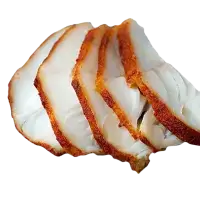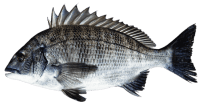Orange roughy raw nutrition: calories, carbs, GI, protein, fiber, fats
Fish, roughy, orange, raw
*all the values are displayed for the amount of 100 grams
Important nutritional characteristics for Orange roughy raw

|
Glycemic index ⓘ
Source: *Explanation
Check out our Glycemic index chart page for the full list.
|
0 (low) |
| Calories ⓘ Calories per 100-gram serving | 76 |
| Net Carbs ⓘ Net Carbs = Total Carbohydrates – Fiber – Sugar Alcohols | 0 grams |
| Serving Size ⓘ Serving sizes are taken from FDA's Reference Amounts Customarily Consumed (RACCs) | 3 oz (85 grams) |
| Acidity (Based on PRAL) ⓘ PRAL (Potential renal acid load) is calculated using a formula. On the PRAL scale the higher the positive value, the more is the acidifying effect on the body. The lower the negative value, the higher the alkalinity of the food. 0 is neutral. | 7.9 (acidic) |
| Oxalates ⓘ Animal products do not contain oxalate. | 0mg |
Selenium ⓘHigher in Selenium content than 79% of foods
Protein ⓘHigher in Protein content than 68% of foods
Cholesterol ⓘHigher in Cholesterol content than 67% of foods
Folate, food ⓘHigher in Folate, food content than 63% of foods
Retinol ⓘHigher in Retinol content than 63% of foods
Orange roughy raw calories (kcal)
| Serving Size | Calories | Weight |
|---|---|---|
| Calories in 100 grams | 76 | |
| Calories in 3 oz | 65 | 85 g |
Orange roughy raw Glycemic index (GI)
Source:
*Explanation
Check out our Glycemic index chart page for the full list.
Mineral coverage chart
Calcium:
9 mg of 1,000 mg
1%
Iron:
1.01 mg of 8 mg
13%
Magnesium:
17 mg of 420 mg
4%
Phosphorus:
107 mg of 700 mg
15%
Potassium:
167 mg of 3,400 mg
5%
Sodium:
72 mg of 2,300 mg
3%
Zinc:
0.23 mg of 11 mg
2%
Copper:
0.075 mg of 1 mg
8%
Manganese:
0.05 mg of 2 mg
2%
Selenium:
66.7 µg of 55 µg
121%
Choline:
0 mg of 550 mg
0%
Mineral chart - relative view
Selenium
66.7 µg
TOP 21%
Sodium
72 mg
TOP 57%
Iron
1.01 mg
TOP 59%
Phosphorus
107 mg
TOP 62%
Copper
0.075 mg
TOP 66%
Manganese
0.05 mg
TOP 66%
Potassium
167 mg
TOP 67%
Magnesium
17 mg
TOP 68%
Calcium
9 mg
TOP 79%
Zinc
0.23 mg
TOP 83%
Vitamin coverage chart
Vitamin A:
70 IU of 5,000 IU
1%
Vitamin E :
1.2 mg of 15 mg
8%
Vitamin D:
0 µg of 10 µg
0%
Vitamin C:
0 mg of 90 mg
0%
Vitamin B1:
0.031 mg of 1 mg
3%
Vitamin B2:
0.045 mg of 1 mg
3%
Vitamin B3:
1.53 mg of 16 mg
10%
Vitamin B5:
0.051 mg of 5 mg
1%
Vitamin B6:
0.052 mg of 1 mg
4%
Folate:
26 µg of 400 µg
7%
Vitamin B12:
0.38 µg of 2 µg
16%
Vitamin K:
0.7 µg of 120 µg
1%
Vitamin chart - relative view
Folate
26 µg
TOP 44%
Vitamin E
1.2 mg
TOP 44%
Vitamin A
70 IU
TOP 46%
Vitamin B12
0.38 µg
TOP 52%
Vitamin B3
1.53 mg
TOP 62%
Vitamin B6
0.052 mg
TOP 77%
Vitamin K
0.7 µg
TOP 79%
Vitamin B1
0.031 mg
TOP 81%
Vitamin B2
0.045 mg
TOP 82%
Vitamin B5
0.051 mg
TOP 93%
Vitamin C
0 mg
TOP 100%
Macronutrients chart
Protein:
Daily Value: 33%
16.41 g of 50 g
33%
Fats:
Daily Value: 1%
0.7 g of 65 g
1%
Carbs:
Daily Value: 0%
0 g of 300 g
0%
Water:
Daily Value: 4%
75.67 g of 2,000 g
4%
Other:
7.22 g
Protein quality breakdown
Tryptophan:
184 mg of 280 mg
66%
Threonine:
740 mg of 1,050 mg
70%
Isoleucine:
767 mg of 1,400 mg
55%
Leucine:
1293 mg of 2,730 mg
47%
Lysine:
1490 mg of 2,100 mg
71%
Methionine:
526 mg of 1,050 mg
50%
Phenylalanine:
626 mg of 1,750 mg
36%
Valine:
789 mg of 1,820 mg
43%
Histidine:
338 mg of 700 mg
48%
Fat type information
Saturated Fat:
0.015 g
Monounsaturated Fat:
0.239 g
Polyunsaturated fat:
0.109 g
All nutrients for Orange roughy raw per 100g
| Nutrient | Value | DV% | In TOP % of foods | Comparison |
| Calories | 76kcal | 4% | 79% |
1.6 times more than Orange
|
| Protein | 16.41g | 39% | 32% |
5.8 times more than Broccoli
|
| Fats | 0.7g | 1% | 78% |
47.6 times less than Cheddar Cheese
|
| Vitamin C | 0mg | 0% | 100% |
N/A
|
| Net carbs | 0g | N/A | 75% |
N/A
|
| Carbs | 0g | 0% | 100% |
N/A
|
| Cholesterol | 60mg | 20% | 33% |
6.2 times less than Egg
|
| Iron | 1.01mg | 13% | 59% |
2.6 times less than Beef broiled
|
| Calcium | 9mg | 1% | 79% |
13.9 times less than Milk
|
| Potassium | 167mg | 5% | 67% |
1.1 times more than Cucumber
|
| Magnesium | 17mg | 4% | 68% |
8.2 times less than Almond
|
| Sugar | 0g | N/A | 100% |
N/A
|
| Fiber | 0g | 0% | 100% |
N/A
|
| Copper | 0.08mg | 8% | 66% |
1.9 times less than Shiitake
|
| Zinc | 0.23mg | 2% | 83% |
27.4 times less than Beef broiled
|
| Phosphorus | 107mg | 15% | 62% |
1.7 times less than Chicken meat
|
| Sodium | 72mg | 3% | 57% |
6.8 times less than White Bread
|
| Vitamin A | 70IU | 1% | 46% |
238.7 times less than Carrot
|
| Vitamin A RAE | 21µg | 2% | 43% | |
| Vitamin E | 1.2mg | 8% | 44% |
1.2 times less than Kiwifruit
|
| Selenium | 66.7µg | 121% | 21% | |
| Manganese | 0.05mg | 2% | 66% | |
| Vitamin B1 | 0.03mg | 3% | 81% |
8.6 times less than Pea raw
|
| Vitamin B2 | 0.05mg | 3% | 82% |
2.9 times less than Avocado
|
| Vitamin B3 | 1.53mg | 10% | 62% |
6.3 times less than Turkey meat
|
| Vitamin B5 | 0.05mg | 1% | 93% |
22.2 times less than Sunflower seed
|
| Vitamin B6 | 0.05mg | 4% | 77% |
2.3 times less than Oat
|
| Vitamin B12 | 0.38µg | 16% | 52% |
1.8 times less than Pork
|
| Vitamin K | 0.7µg | 1% | 79% |
145.1 times less than Broccoli
|
| Folate | 26µg | 7% | 44% |
2.3 times less than Brussels sprout
|
| Saturated Fat | 0.02g | 0% | 92% |
393 times less than Beef broiled
|
| Monounsaturated Fat | 0.24g | N/A | 77% |
41 times less than Avocado
|
| Polyunsaturated fat | 0.11g | N/A | 84% |
432.8 times less than Walnut
|
| Tryptophan | 0.18mg | 0% | 68% |
1.7 times less than Chicken meat
|
| Threonine | 0.74mg | 0% | 67% |
Equal to Beef broiled
|
| Isoleucine | 0.77mg | 0% | 68% |
1.2 times less than Salmon raw
|
| Leucine | 1.29mg | 0% | 69% |
1.9 times less than Tuna Bluefin
|
| Lysine | 1.49mg | 0% | 66% |
3.3 times more than Tofu
|
| Methionine | 0.53mg | 0% | 63% |
5.5 times more than Quinoa
|
| Phenylalanine | 0.63mg | 0% | 71% |
1.1 times less than Egg
|
| Valine | 0.79mg | 0% | 70% |
2.6 times less than Soybean raw
|
| Histidine | 0.34mg | 0% | 73% |
2.2 times less than Turkey meat
|
| Omega-3 - EPA | 0g | N/A | 43% |
172.5 times less than Salmon
|
| Omega-3 - DHA | 0.02g | N/A | 39% |
97.3 times less than Salmon
|
| Omega-3 - ALA | 0g | N/A | 99% |
3046.7 times less than Canola oil
|
| Omega-3 - DPA | 0g | N/A | 52% |
170 times less than Salmon
|
| Omega-6 - Eicosadienoic acid | 0.04g | N/A | 74% |
Check out similar food or compare with current
NUTRITION FACTS LABEL
Nutrition Facts
___servings per container
Serving Size ______________
Serving Size ______________
Amount Per 100g
Calories 76
% Daily Value*
2%
Total Fat
1g
0%
Saturated Fat 0g
20%
Cholesterol 60mg
3%
Sodium 72mg
0%
Total Carbohydrate
0g
0%
Dietary Fiber
0g
Total Sugars g
Includes ? g Added Sugars
Protein
16g
Vitamin D
0mcg
0%
Calcium
9mg
1%
Iron
1mg
13%
Potassium
167mg
5%
*
The % Daily Value (DV) tells you how much a nutrient in a serving of food contributes to a daily diet. 2,000 calories a day is used for general nutrition advice.
Health checks
Low in Cholesterol
ⓘ
Dietary cholesterol is not associated with an increased risk of coronary heart disease in healthy individuals. However, dietary cholesterol is common in foods that are high in harmful saturated fats.
Source
No Trans Fats
ⓘ
Trans fat consumption increases the risk of cardiovascular disease and mortality by negatively affecting blood lipid levels.
Source
Low in Saturated Fats
ⓘ
Saturated fat intake can raise total cholesterol and LDL (low-density lipoprotein) levels, leading to an increased risk of atherosclerosis. Dietary guidelines recommend limiting saturated fats to under 10% of calories a day.
Source
Low in Sugars
ⓘ
While the consumption of moderate amounts of added sugars is not detrimental to health, an excessive intake can increase the risk of obesity, and therefore, diabetes.
Source
References
All the values for which the sources are not specified explicitly are taken from FDA’s Food Central. The exact link to the food presented on this page can be found below.


